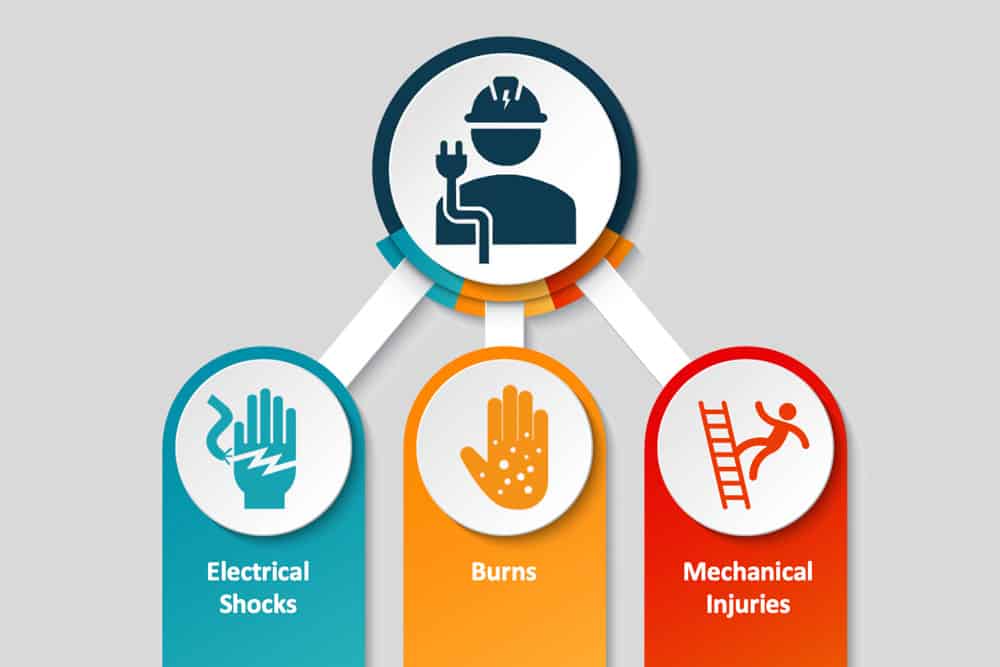
Portable appliance testing is performed on electronic devices as a way of detecting faults and defects in those devices. commonly referred to as PAT or PAT testing, is essential for business owners and those responsible for any premises.
As employers, we have a duty to our employees, clients and the public to ensure our electrical appliances are safe. And PAT is a vital tool for doing this. But what exactly PAT involves isn’t necessarily well known.
In this article, we will take a closer look at everything you need to know about PAT, including where it is needed, how it is done, how often do PAT tests need to be done, and – importantly – who can do it.
What is Portable Appliance Testing?
Portable appliance testing, commonly referred to as PAT or PAT testing, is essential for business owners and those responsible for any premises.
Technically called combined inspections and tests, PAT is a systematic examination of electrical appliances to ensure that they are safe to use. Most of the issues in electronic devices can usually be found through a visual inspection, though they don’t cover all bases. PAT testing can cover some of those areas, though not all.
Is PAT Testing a Legal Requirement?
As per the PAT testing regulations, there is no legal requirement to conduct PAT testing by itself. However, it is considered best practice. And, furthermore, it will ensure legal compliance with health and safety regulations that pertain to electrical appliances.
But the legal pat testing requirements to protect people from electrical risks are not just legislative. Electricity is a real hazard. Such as was made clear when an 11-year-old boy came into contact with faulty lighting in a beer garden in East London in 2018. The incident resulted in the child’s tragic death and a nine-year jail sentence for the pub’s owner.
While such incidents are fortunately rare, there are countless accidents and incidents involving electricity that occur every year. In particular if you consider the fire hazards posed by faulty electrical appliances. According to government data, of the nearly 30,000 fires seen in England in 2018, some 44% were due to electrical faults.
What Exactly Are Portable Appliances?
There is no universal definition for what portable appliances are. But, generally, portable electrical appliances (PEAs) include any electrical equipment that is capable of being moved from one place to another.
Typically, these appliances weigh less than 18kg and usually are connected to the mains via a power cable and plug. Some common examples are computers, kettles, printers, coffee machines, copiers, vacuum cleaners, and screen monitors.
Some larger appliances that are also considered PEAs include fridges, washing machines, water coolers, desktop computers, and vending machines.
Why Test My Portable Appliances?
Integrating PAT into our electrical appliance risk controls will ensure that your property is legally compliant and safe for employees or anyone that may be exposed. The three biggest risks we need to worry about in terms of faulty appliances are electric shocks, burns and fires.

Electric Shocks
Electric shock injuries occur when we create a circuit from an electrical supply to the ground or earth. The sudden flow of electrical current through our body can cause muscle damage, nerve damage, and temporary paralysis. As the heart runs on electricity, cardiac arrest is also a risk.
Burns
Burns can be caused by the arc flash between the conductor (a body) and the live contact (electrical source). An arc flash can reach high temperatures and burn the skin tissue almost immediately at contact. Higher voltages and longer contact can burn internal tissues, causing permanent damage to the organs.
Fires
Faulty sockets and appliances are one of the leading causes of fires in the UK. This often occurs when an out-of-date appliance, for instance, with a worn cord transmits heat into a combustible surface, such as a curtain, a rug or flooring
Portable Appliance Testing Regulations
As mentioned, no specific portable appliance testing regulations actually exist. In other words, there is not pat test legal requirement that is mandatory by law.
What the law does say is that it is the responsibility of all employers to ensure that their electrical equipment is safe for use. This can also be done via risk assessment. However, it is largely recognised that regularly conducting PAT is best practice.
Your legal requirements for electrical safety are outlined under the following legislation:
The Health & Safety at Work Act 1974
Under the Health and Safety at Work Act 1974 employers have duties towards their workers and the public. They must provide necessary health and safety information and training to their employees.
It also dictates that employers must maintain a safe working environment and use good management to mitigate accidents, such as ensuring equipment is safe to use. Read more
The Management of Health & Safety at Work Regulations 1999
This law stipulates that employers must have arrangements to control risks associates with health and safety of the employees. It requires businesses to draft written policies and risk assess hazards to protect anyone that may be affected by their activities. (source)
The Electricity at Work Regulations 1989
This regulation lays out rules on the purchase, installation, and use of electrical equipment. These rules are relevant to a broad spectrum of work activities carried inside and outside premises. The law states all electrical systems must be maintained suitably to prevent injury or harm. And suitable methods of earthing and other precautions must be in place. (source)
The Provision and Use of Work Equipment Regulations 1998
Often abbreviated PUWER, this law places duties on business owners and companies operating or hiring equipment for work. Such equipment, including electrical appliances, must be managed properly to prevent workplace accidents. It states that work equipment must be:
- Suitable for the intended use
- Maintained in safe working condition
- Inspected and correctly installed
- Used by trained people
- Protected by health and safety measures
The IET Code of Practice
The Institute of Engineering & Technology (IET) for In-Service Inspection and Testing of Electrical Equipment provides detailed guidance on PAT testing. While PAT testing regulations do not exist per se, the IET Code of Practice is the closest thing to it. It gives us thorough guidance on how electrical appliance testing should be conducted.
The 5th edition of IET Code of Practice was released in September 2020, and includes several changes in the terms of layout, management of electrical safety, and visual inspection checks
What Needs PAT Testing?
Most appliances that can store or discharge electrical current require PAT. To understand where testing is required, it is important to understand how equipment is classed.
Electrical appliances are divided into 2 main classes, Earthed and Double-Insulated.
Class 1 (Earthed)
This type of equipment has basic insulation and depends on earth connection for safety. A fault in the equipment can result in an electrical shock from outside of the equipment if the earth connection is absent. Examples of class 1 equipment include kettles, toasters, irons, and electric heaters.
Class 1 equipment likely presents the highest risk, so will also likely require more frequent testing.
Class 2 (Double Insulated)
Class 2 equipment is safer than class 1 as it does not rely on earth for safety. These appliances are double insulated, which makes them much safer. Examples of class 2 equipment include hairdryers, televisions, lamps, and power tools.
Class 2 presents less risk. However, this does not mean it does not need testing.
Class 3
Class 3 equipment is extra low voltage equipment, such as appliances that are battery operated. This includes things like cell phones and digital cameras. These items do not generally require testing.
How Often Should Items be PAT Tested?
There is no PAT testing law that requires the specific PAT test to be conducted. It also does not define a frequency for when it must occur. As mentioned, under electrical regulations you simply are expected to do what you need to do to keep employees safe.
The HSE does give us some recommendations for frequency in its publication HSG 107 – Maintaining Portable Equipment.
However, the most recent edition of the IET Code of Practice clearly states that the responsibility of determining the frequency of testing falls to the relevant duty holder. So, it’s the responsible person’s job to determine the need for PAT.
The four factors that should be considered when risk assessing PAT frequency are:
- The working environment,
- The type of equipment,
- If equipment has been modified or repaired recently
- If any problems have been identified.
The HSE also recommends you consider:
- Manufacturer recommendations
- Equipment age
- How often it is used
- Foreseeable misuse of the appliance
- History of the appliance
What does Portable Appliance Testing Involve?
PAT testing is technically referred to as combined inspections and tests. This is because PAT literally combines a formal visual inspection with a series of electrical tests to ensure that an appliance is working as it should and has no faults.
Formal Visual Inspection
The formal visual inspection includes checking the following areas of the appliance for any obvious faults.
- Casing & overall condition of the appliance
- Cable
- Plug
- Inside of the plug
- Fuse
Testing
Testing involves using a portable appliance testing device to run a series of tests on the appliance. There are a variety of testers on the market. Most testers are relatively easy to use and will run through all of the tests for the class of appliance that you are testing in one go.
These tests include:
- Earth continuity (Class 1)
- Insulation resistance (Class 1 & 2)
- Lead polarity (Class 1 & 2)
- Leakage (Class 1 & 2)
Results of Tests
If an appliance fails any part of the visual inspection or test, it must be marked as failed and be put out of use – so that nobody will use the appliance. In cases where a faulty appliance presents a high level of risk, the cable should be cut to ensure safety.
Those that pass must be appropriately labelled.
All PAT should be clearly recorded.
Who Can Conduct Portable Appliance Testing?
You do not need a specific level of certification or to be an electrician to conduct PAT. However, it does require that you are suitably competent for the complexity of the equipment. You must be able to understand the testing devices you use and understand the results.
So, in simple terms, you must know how to do PAT safely and give accurate assessments of the appliances you have tested. The duty holder must determine if you are suitably competent to do so. Your level of skill may need to be higher for more complex testing.
For simple appliance testing, this is a skill that can be learned given the appropriate training.
PAT Training Courses
There are a variety of PAT training courses on the market. Some training can be provided in a face to face environment. Although this can be costly and time consuming. You can also earn a PAT testing certificate from online training providers.
But when choosing a provider of online PAT training, keep in mind that not all courses are the same. Some may only provide you with a cursory explanation of PAT and not include clear demonstrations of how to run the tests.
The Human Focus PAT training course walks through all of the information you require to understand the PAT process. It looks at the duties, the types of equipment you may test, and what is needed to do those tests. Most importantly, it walks you through actual tests, so you can see exactly how it is done. It also comes with a PAT testing checklist, so you can keep track of the individual tests for electronics.
To learn more about Human Focus’s RoSPA-certified PAT Testing programme, click here.

















































































































































































































































































































































































































































































































































































































































































































































